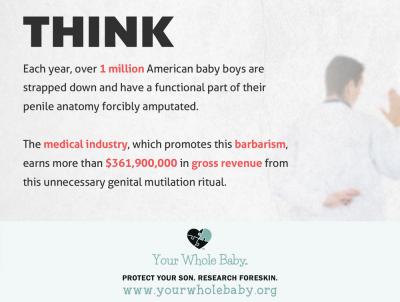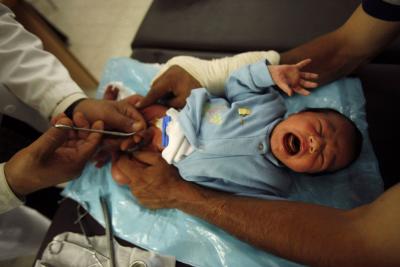A Doctor-Sanctioned Abuse Becomes Culturally Accepted
Infant/childhood male circumcision was not widely practiced (outside of Jewish and Muslim traditions) until the early 1900s. Around that time, doctors began promoting circumcision as a "fix" for habitual masturbation (which was thought to cause insanity and other mental illnesses) and a "cure" for virtually any ailment that was common in society at a particular time. For decades, a money-hungry medical industry promoted these false benefits while continuously downplaying the risks and complications. Doctors rarely gave parents full disclosure about details of the actual procedure, which almost always happened behind closed doors. Nor would they reveal the brutality and extreme pain involved. If a parent questioned this aspect, they were told that the child couldn't feel pain and/or that the child wouldn't remember it anyway. Doctors rarely explained that the pain management techniques were woefully inadequate - if they used any at all. In actuality, the pain is so intense from this trauma that babies can enter a state of shock, but parents were told this shows that "he slept right through it." These cover-ups and outright lies continue today.
In the span of only two or three generations, circumcision became the most common surgery in America. Because of its prevalence by the 1970s, '80s, and '90s, most new parents just assumed it had always been done. An untold millions of non-consenting children have been subjected to this painful cut. Unfortunately, it still happens to hundreds of boys each day, simply to continue a perceived family tradition.
Done in Secrecy, Rumors and Myths Abound
Until recently, circumcision was rarely discussed openly, because mentioning those parts of the body was considered too taboo. This veil of secrecy generated many extremely common myths. Incorrect care and cleaning procedures for the natural intact (uncircumcised) boys often created many real problems which would not have occurred, if proper intact care had been followed. If and when a conversation was brought up, a hushed "I know a guy who..." story was almost always included. These rumors fueled rampant misconceptions about the natural foreskin, and instilled an irrational fear of infection. With a strong social stigma building, parents rushed to circumcise their boys as soon as possible, even just hours after birth.
Circumcision Facts Exposed
At the most basic level, the word circumcision means "a circular cut," and the word circumcise means "to cut around." In the context of what happens to boys, it is the process of cutting around his penis in order to remove his foreskin. The foreskin is often inadequately described as a "little piece of extra skin" that covers the glans ("head") of the penis. In actuality, it is not little, nor is it extra. Relative to the size of the penis as a whole, the foreskin is roughly half of the total penile skin, and it has a very important contribution to daily comfort as well as the natural mechanics of sexual encounters.
Circumcision is extremely painful, no matter at what age it is performed. It is unfair (and unethical, and wrong) to suggest that because infants and young children usually don't remember events from their first few years, it is acceptable to force this procedure on them at a young age. In reality, an adult has a much higher pain tolerance, can be given more effective pain management, and most importantly can make the decision for himself.
Infant circumcision carries a risk of quite a number of complications, many of which do not manifest until puberty, when a child is unlikely to report the problems to his parents. These complications and risks are lessened if not eliminated when the circumcision is postponed until adulthood.
In almost all cases, circumcision is medically unnecessary. The foreskin is a completely natural, functioning, and healthy part of the body - rarely is there an actual medical problem involved that necessitates its removal. Often parents are compelled to circumcise their son primarily for cosmetic reasons - so the boy will "look like daddy," as if the circumcision status will somehow outweigh the differences in size and hair coverage.
Breaking Through the Taboo and Protecting Children
Thankfully, the stigma is breaking down. Decades ago, a grassroots movement to end the cycle started with a few individuals who were brave enough to start speaking publicly, usually on their own. As the Internet took shape, it provided new ways to coordinate efforts, and gave the message a much larger platform to reach the public. Read more about the accomplishments of the key influential leaders in the effort of ending child circumcision.
Every day, more and more people are joining the "intactivist" movement (a word-smash of "intact activists") and working to protect the next generation of children, advocating that their bodies should be left intact. When parents are provided with truthful, factual information on the harms of infant circumcision and the benefits of leaving the child's body whole and intact, it becomes clear that the circumcision decision should be left to the person to whom the penis is attached, not his parents.


